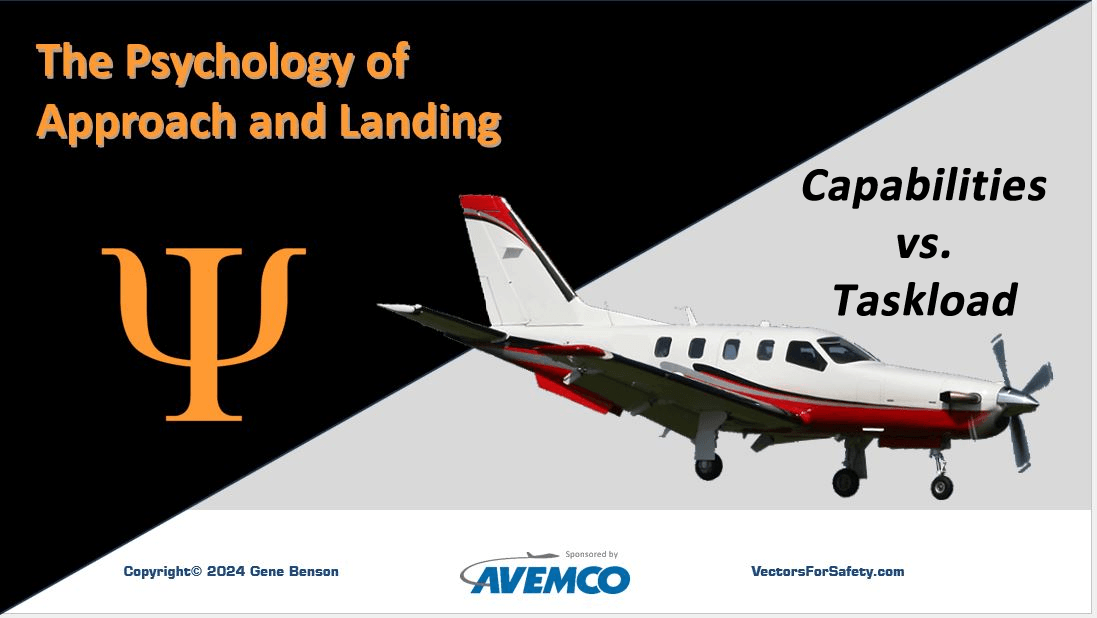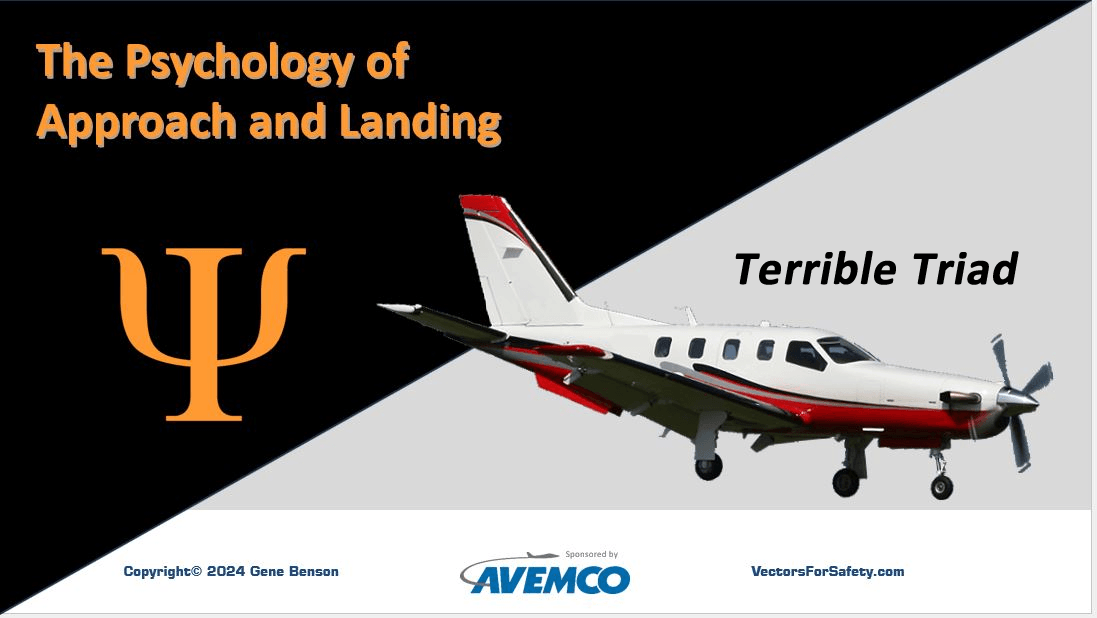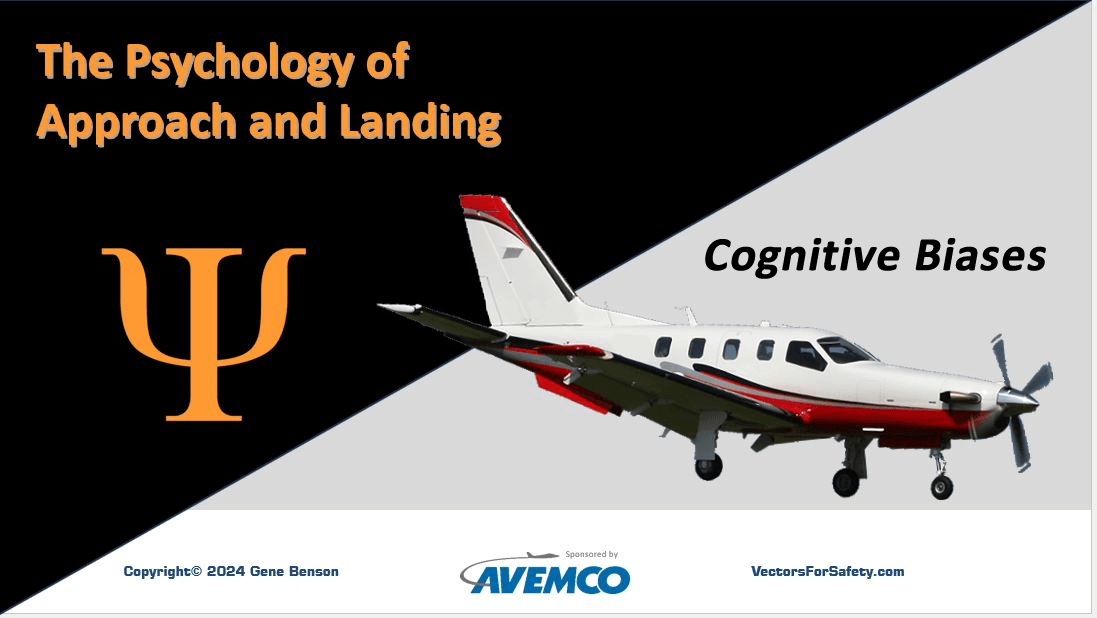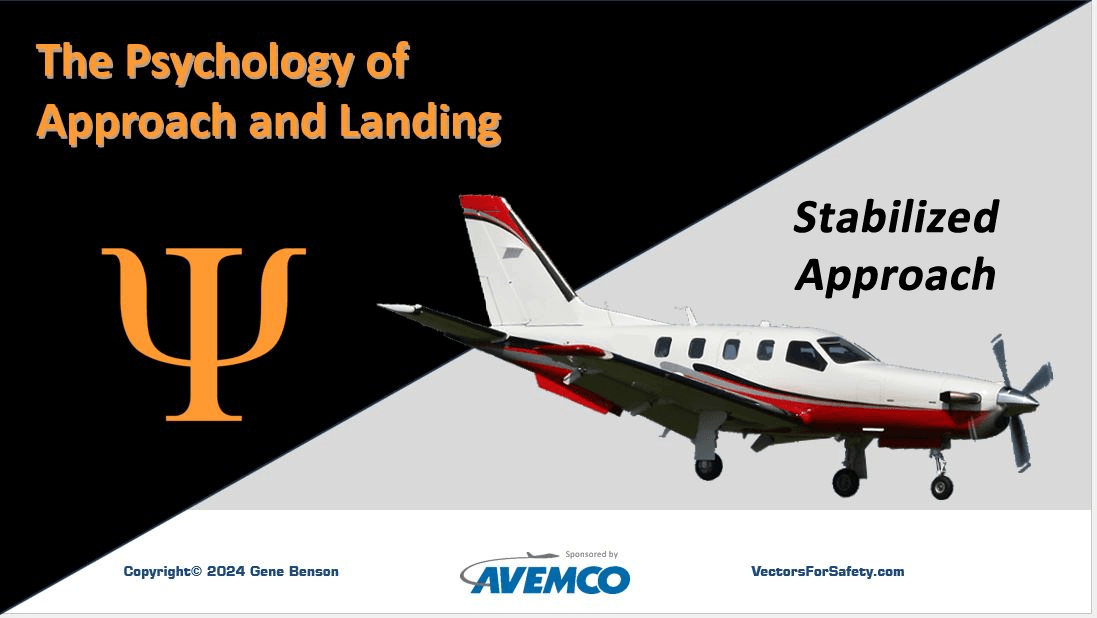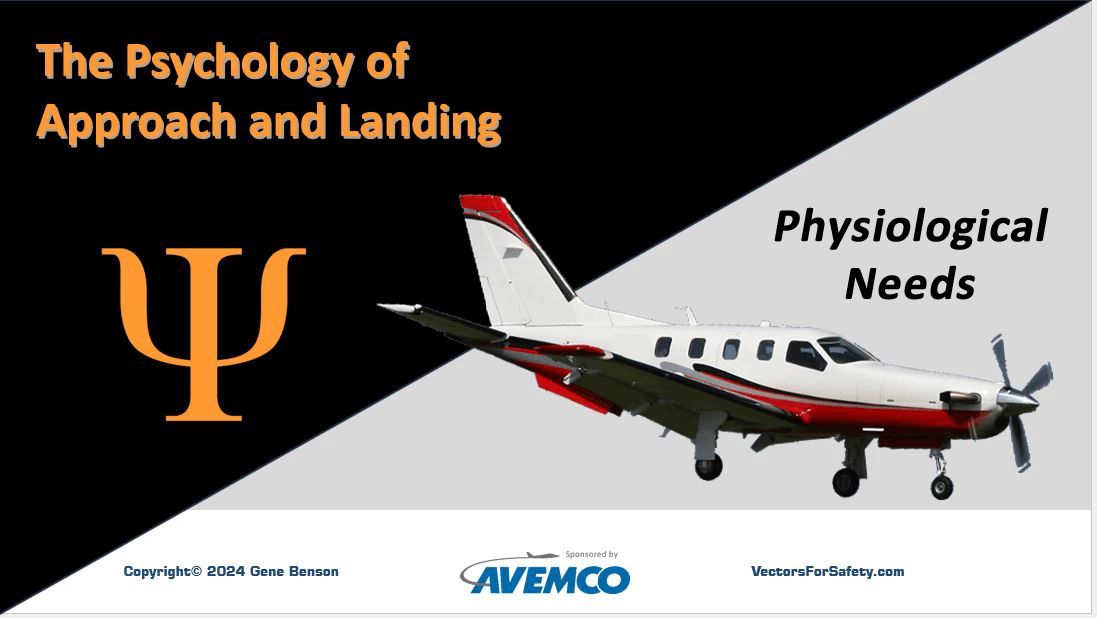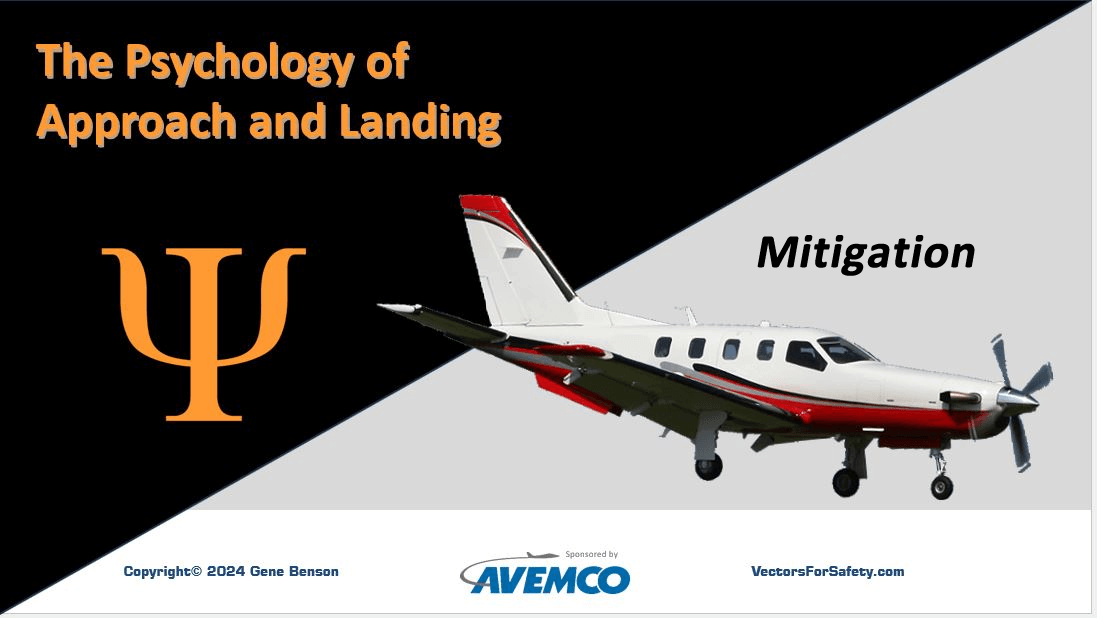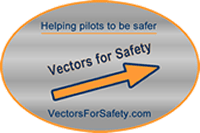
- Home
- Articles
- Privacy Policy
- Home
- Articles
- Privacy Policy
The Psychology of Approach and Landing
Created and narrated by Gene Benson


About the Course
This course is presented free of charge courtesy of Avemco Insurance
It has been said that takeoffs are optional but landings are mandatory. Pilots must demonstrate proficiency in several different types of landings before their first solo flight and for each certification checkride. Most pilots take pride in their landings. Afterall, passengers tend to silently evaluate the pilot's skill for the entire flight based on the quality of the landing.
Yet, approach and landing accidents account for the greatest number of accidents examined by the NTSB. These accidents involve pilots of every certification level and range from low time pilots to pilots having more than 20,000 flight hours of experience.
That raises the question of why we have so many landing accidents. Perhaps it is because all pilots are human and therefore subject to unconscious influence that drives flawed decisions. We will explore the psychology of being human as it relates to pilots, focusing on the "Psychology of Approach and Landing."
The course consists of text, videos, an eexercise, accident examples, and a quiz. Successful completion of the course, including the quiz, is valid for 1 credit for the Wings Basic Knowledge Level Topic-1 and 1 credit for the Wings Basic Knowledge Level Topic-3. The FAA designation for the course is ALC-1343.
Sucessful completion of the course also qualifies for the Avemco Safety Rewards Program.
Just This Once - Landings Edition
Click the image below to view a 16-minute video titled "Just This Once - Landings Edition." The video is part of a series that explores how pilots may make a decision to do something that is contrary to their training, to regulations, or to standard operating procedures, with the thought that it will be fine "Just This Once."
Exercise
Accident Analysis
Accidents discussed in this section are presented in the hope that pilots can learn from the misfortune of others and perhaps avoid an accident. It is easy to read an accident report and dismiss the cause as carelessness or as a dumb mistake. But let's remember that the accident pilot did not get up in the morning and say, "Gee, I think I'll go have an accident today." Nearly all pilots believe that they are safe. Honest introspection frequently reveals that on some occasion, we might have traveled down that same accident path.

This crash happened in Indiana eight days before Christmas 2021. The airplane was a Piper PA-32R-300. The 40-year-old instrument rated private pilot left behind a wife and three children. The pilot had 448 flight hours total time with 219 in this make and model.
The NTSB accident report includes the following: "Automatic dependent surveillance – broadcast (ADS-B) and Federal Aviation Administration (FAA) air traffic data revealed that the pilot initially departed Chicago Executive Airport (PWK) at 1618 central standard time en route to Indianapolis Metro Airport (UMP), arriving at 1844 eastern standard time. He subsequently departed UMP at 1925 eastern standard time with an intended destination of BMG. After departure from UMP, the airplane proceeded on course to the southwest, then to the south, and climbed to an altitude of about 4,000 ft mean sea level (msl). Upon contacting the BMG approach controller, the pilot was instructed to descend to 3,000 ft msl and issued radar vectors for the instrument landing system approach to runway 35."

The NTSB report continues: "About 2003, the controller issued an intercept heading to the pilot and cleared him for the approach. About 2005, the pilot reported that the flight was established on the approach and the controller instructed the pilot to contact the control tower. The tower controller subsequently cleared the pilot to land; however, the pilot never responded. The airplane tracked inbound along the ILS runway 35 localizer. At 2006:58, the airplane passed the final approach fix (NITTE); the airplane’s altitude was about 2,258 ft msl at that time. After the airplane passed NITTE, the flight path appeared to become more erratic in comparison to the airplane flight path before passing NITTE. At 2008:15, the airplane entered a right turn approximately 2.25 miles from the runway. The final data point was recorded at 2008:29; the airplane’s altitude was about 1,045 ft msl at that time.
Airspeed and climb/descent rates derived from ADS-B position and altitude data indicated the airplane was stabilized about 3,000 ft msl and 120 knots until about 1959. The airspeed then decreased and appeared to stabilize about 110 knots with the airplane remaining about 3,000 ft msl. At 2002:20, a momentary altitude deviation was recorded consisting of a 200 ft loss immediately followed by a 300 ft gain. During this time, the airspeed initially increased and then decreased to as low as 90 knots before recovering. From 2003:00 until 2006:40, the airplane entered a general descent with momentary level offs or climbs. Airspeed during this timeframe increased to about 150 knots before decreasing again. Beginning at 2006:40, the airplane entered a continuous descent until the final data point. The average airplane descent rate between the final approach fix and the final ADS-B data point varied from about 400 fpm to over 1,200 fpm."
The NTSB probable cause finding states: "The pilot’s failure to follow the instrument landing system (ILS) course guidance, which resulted in the pilot’s loss of airplane control during the instrument approach. Contributing to the accident was the presence of turbulence and low-level wind shear."

Again, we see a family tragedy. Though the unstable approach was not mentioned in the probable cause finding, the approach was clearly unstable as mentioned in the analysis text. The pilot's workload during the approach caused the task load to exceed the pilot's capabilities. The pilot had completed a flight review twelve days prior to the crash. According to the pilot's logbook, copies of which are included in the accident docket, the flight review was conducted in a Cessna 172. A considerably slower and much less complex airplane than the Piper Lance. Also, the log entry for the flight review did not list any instrument flight time. The logbook listed actual instrument time as 110.3 and simulated instrument time as 52.7 hours respectively. The logbook appears to indicate that the pilot met recent experience requirements regarding instrument flight hours, but that he had logged only four of the six required instrument approaches. There is no indication of an instrument proficiency check having been completed.
We owe it to our families to take all reasonable steps to maintain our proficiency at a high level. We must be honest with ourselves regarding our capabilities for this flight, on this day, with our present level of proficiency.
Accident Analysis
Accidents discussed in this section are presented in the hope that pilots can learn from the misfortune of others and perhaps avoid an accident. It is easy to read an accident report and dismiss the cause as carelessness or as a dumb mistake. But let's remember that the accident pilot did not get up in the morning and say, "Gee, I think I'll go have an accident today." Nearly all pilots believe that they are safe. Honest introspection frequently reveals that on some occasion, we might have traveled down that same accident path.

This crash took the life of the 76-year-old, 14,000 hour, ATP flying a Beech B35 Bonanza. The crash happened in Indiana in August of 2022. The NTSB accident report includes the following: "The pilot was returning to his home airport at the conclusion of a cross-country flight and was attempting to make a visual approach to land at night. A review of radar data revealed the airplane overflew the airport about 500 ft above the ground before making a sweeping, descending left turn onto final approach before the data ended 0.2 miles from the end of the runway. At that time, the airplane was traveling at a groundspeed of about 86 knots at an altitude of about 33 ft above ground level (agl). Airport surveillance video captured the airplane on landing rollout. The airplane was observed departing the left side of the runway before it started a climb and impacted trees."
The NTSB report also includes the following: "Based on the available radar data, the pilot had not stabilized the airplane during the approach to the runway and was at a critically low altitude when the airplane was .2 miles from the end of the runway. Surveillance video also suggested the airplane was not stabilized after it touched down. Visible tire marks on the runway confirmed that it departed the left side of the runway during the landing rollout. The pilot may have attempted to regain control of the airplane after the unstabilized approach, touchdown, and runway excursion by attempting to abort the landing; however, the airplane subsequently collided with trees. Based on this information it is likely that the pilot performed an un stabilized approach that resulted in a loss of directional control during landing, ultimately resulting in a runway excursion and collision with trees."


The NTSB probable cause finding states: "The pilot’s failure to make a stabilized approach, which resulted in a loss of directional control during landing.".

A 14,000 hour ATP most certainly knew all about stabilized approaches and how critical they are to a safe landing. Why did he continue? Perhaps our favorite cognitive biases, illusory superiority, optimism bias, and continuation bias were at work. Maybe if he had established an approach decision gate he would have executed the go-around sooner and successfully.
Conclusion
We began by looking at some unfortunate statistics regarding approach and landing accidents. We went on to examine a variety of factors that can adversely affect a pilot's decision making. We saw a reminder on the importance of a stabilized approach, how our physiological needs can influence our decisions, and the danger of deviating from our training, established procedures, or regulations "Just This Once." We saw a brief exercise to help cement some of the concepts. We concluded with some ideas on how to mitigate those influences and we saw the analysis of two related accidents.
Thank you for taking our course and always remember to "Fly like your life depends on it!"
QUIZ
About the Quiz
To earn FAA Wings credit for this course, you must complete and pass the 15-question, multiple choice quiz. 70% is the minimum passing grade meaning that you must answer at least 11 questions correctly. There is no time limit on completing the quiz. You may review the questions and change your responses if you wish prior to submitting the quiz. Once the quiz has been submitted, you will see your score on the screen. Upon seeing your score, you will have an option to revise any incorrect answers and submit the the quiz again.
Copyright © 2025 Gene Benson. All rights reserved.



